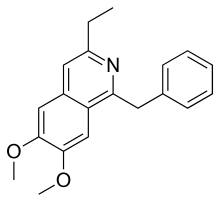Moxaverine
Moxaverine has been used in therapy based on the direct vasodilatory effect of the drug, a phosphodiesterase inhibitor,[1] and on its influence on the rheological properties of red blood cells.[2]
 | |
| Clinical data | |
|---|---|
| AHFS/Drugs.com | International Drug Names |
| ATC code | |
| Identifiers | |
IUPAC name
| |
| CAS Number | |
| PubChem CID | |
| ChemSpider | |
| UNII | |
| KEGG | |
| CompTox Dashboard (EPA) | |
| ECHA InfoCard | 100.031.003 |
| Chemical and physical data | |
| Formula | C20H21NO2 |
| Molar mass | 307.386 g/mol g·mol−1 |
| 3D model (JSmol) | |
SMILES
| |
InChI
| |
| | |
Moxaverine hydrochloride (Kollateral forte®, Ursapharm. Saarbrücken, Germany) has been shown to increase ocular blood flow in patients with age-related macular degeneration, primary open angle glaucoma, and to increase choroidal and retrobulbar blood flow in elderly patients with eye diseases associated with hypo-perfusion.[3] The ocular efficacy of moxaverine has been explored in the clinic.[4]
References
- Mannhold R (December 1988). "Inhibition of calmodulin dependent c-AMP-phosphodiesterase by moxaverine and papaverine". Arzneimittelforschung. 38 (12): 1806–8. PMID 2854468.
- Schmid-Schönbein, H; Schröder, S; Grebe, R; Artmann, G; Eschweiler, H; Teitel, P (1988). "Influence of moxaverine hydrochloride on membrane curvature and microsieve filterability of red cells after exposure to hyperosmolarity and lactacidosis". Arzneimittelforschung. 38: 710–716. PMID 3415714.
- Pemp, B; Garhofer, G; Lasta, M; Schmidl, D; Wolzt, M; Schmetterer, L (2012). "The effects of moxaverine on ocular blood flow in patients with age-related macular degeneration or primary open angle glaucoma and in healthy control subjects". Acta Ophthalmol. 90: 139–145. doi:10.1111/j.1755-3768.2010.01878.x. PMID 20456253.
- "A Randomized, Placebo-controlled Study Investigating the Effects of Moxaverine on Ocular Blood Flow After Oral Administration in Healthy Subjects".
This article is issued from
Wikipedia.
The text is licensed under Creative
Commons - Attribution - Sharealike.
Additional terms may apply for the media files.